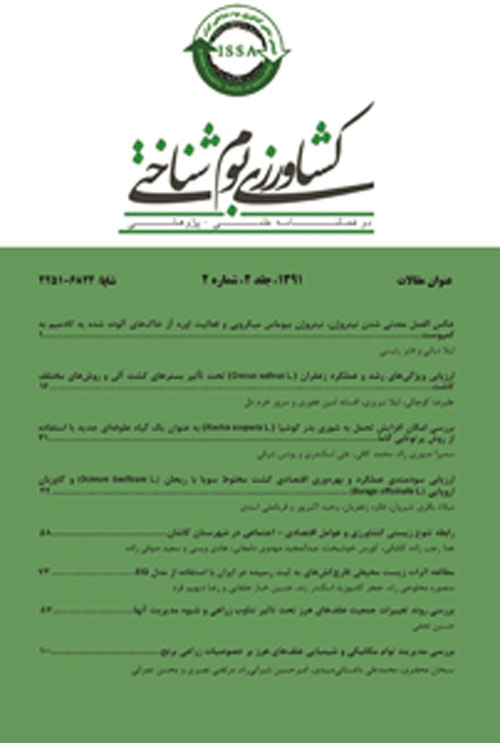Influence of crop management practices and soil characteristics on weed population and soil seed bank in soybean fields
Author(s):
Abstract:
Introduction
To design effective weed population control measures, the identification, characterization, and quantification of weed species within a certain area are important steps to form the basis for weed management (Kropff and Spitters 1991). Information on weed density, distribution, and species composition might also help to predict crop yield losses due to weeds and can help determine whether it is economical to control a specific weed problem. The population and seed bank of weeds is very dynamic. The population dynamics of these plants depends on climate and soil factors and farm management practices (Firehun and Tamado, 2006; Kumara et al. 2007; Derksen et al. 2002). Thus, the objectives of this study were to determine the composition and the soil seed bank of weeds in soybean fields in Kalaleh, Golestan Province, and to assess the influence of soil types and major agronomic practices on weed species and the soil seed bank.Materials And Methods
This study was performed to assess the influence of crop management practices and soil characteristics on density and composition of weed seedling and the soil seed bank of soybean fields in Kalaleh, Golestan Province, in 2014. Data on crop management practices (rotation, manure and chemical fertilizer used, field area, kinds of herbicide and seeds) and soil characteristics (pH, EC and organic matter) were collected from 200 soybean fields. Samplings of weed populations (seedlings) and the seed bank were carried out at the beginning of soybean growth (before implementing the control) with W method in 50 cm ×50 cm quadrates at 0-10 cm and 10-20 cm depths. Finally, the effects of soil and agronomic practices were investigated on dominant weeds using a multi-variate analysis.Results And Discussion
The survey of weed flora in Kalaleh soybean farms showed 16 plant species (belonging to 13 plant families) had infected the farms. The major observed species were Cyperussp (70.60%), Sorghumhalepense L. (45.42%), Ipomoeaspp. (37.19%), Cucumis melo (30.33%), and Cleomeviscosa L. (27.29%). Seeds of 19 species were observed in depths of 0-10 cm. and 20 species were observed in depths of 10-20 cm. The major species observed in both depths were Amaranthus sp., Portulaca oleraceae L., and Cleomea viscosa L. The results of the multi-variate analysis indicated that the effect of crop management and soil factors had different effects on seedlings and the soil seed bank of weeds. Generally, crop management practices had a greater effect than soil characteristics. In this study, herbicides (seedling and seed bank), manure (seed bank) and pH (seedlings) were the major factors that affected weed population and the seed bank.Conclusion
According to the dominance of five species including Cyperus sp., Sorghum halopenseIpomoea sp.,Cucumis melo and Cleome viscosa in weed flora and the seeds of three species, Amaranthus sp., Portulaca oleraceae and Cleomeviscosa in the soil seed bank, it can be said that the above species contribute significantly to the reduction of soybean yields in this region. The results showed that farmers management practices have a greater impact on the weed population and the seed bank than soil factors do.Keywords:
Language:
Persian
Published:
Journal of Agroecology, Volume:7 Issue: 1, 2017
Page:
154
magiran.com/p1733941
دانلود و مطالعه متن این مقاله با یکی از روشهای زیر امکان پذیر است:
اشتراک شخصی
با عضویت و پرداخت آنلاین حق اشتراک یکساله به مبلغ 1,390,000ريال میتوانید 70 عنوان مطلب دانلود کنید!
اشتراک سازمانی
به کتابخانه دانشگاه یا محل کار خود پیشنهاد کنید تا اشتراک سازمانی این پایگاه را برای دسترسی نامحدود همه کاربران به متن مطالب تهیه نمایند!
توجه!
- حق عضویت دریافتی صرف حمایت از نشریات عضو و نگهداری، تکمیل و توسعه مگیران میشود.
- پرداخت حق اشتراک و دانلود مقالات اجازه بازنشر آن در سایر رسانههای چاپی و دیجیتال را به کاربر نمیدهد.
In order to view content subscription is required
Personal subscription
Subscribe magiran.com for 70 € euros via PayPal and download 70 articles during a year.
Organization subscription
Please contact us to subscribe your university or library for unlimited access!



